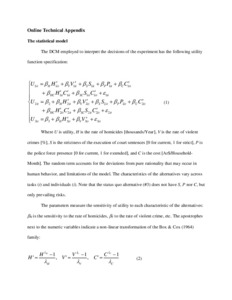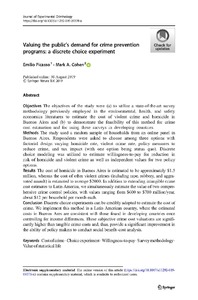Por favor, use este identificador para citar o enlazar este ítem:
https://repositorio.uca.edu.ar/handle/123456789/14651| Campo DC | Valor | Lengua/Idioma |
|---|---|---|
| dc.contributor.author | Picasso, Emilio | es |
| dc.contributor.author | Cohen, Mark A. | es |
| dc.date.accessioned | 2022-08-16T13:35:14Z | - |
| dc.date.available | 2022-08-16T13:35:14Z | - |
| dc.date.issued | 2019 | - |
| dc.identifier.citation | Picasso, E., Cohen, M.A. Valuing the public’s demand for crime prevention programs: a discrete choice experiment [en línea]. Journal of Experimental Criminology. 2019, 15 doi:10.1007/s11292-019-09378-x Disponible en: https://repositorio.uca.edu.ar/handle/123456789/14651 | es |
| dc.identifier.issn | 1573-3750 | - |
| dc.identifier.issn | 1572-831 (online) | - |
| dc.identifier.uri | https://repositorio.uca.edu.ar/handle/123456789/14651 | - |
| dc.description.abstract | Abstract: Objectives: The objectives of the study were (a) to utilize a state-of-the-art survey methodology previously employed in the environmental, health, and safety economics literatures to estimate the cost of violent crime and homicide in Buenos Aires and (b) to demonstrate the feasibility of this method for crime cost estimation and for using these surveys in developing countries. Methods: The study used a random sample of households from an online panel in Buenos Aires. Respondents were asked to choose among three options with factorial design varying homicide rate, violent crime rate, policy measures to reduce crime, and tax impact (with one option being status quo). Discrete choice modeling was utilized to estimate willingness-to-pay for reduction in risk of homicide and violent crime as well as independent values for two policy options. Results: The cost of homicide in Buenos Aires is estimated to be approximately $1.5 million, whereas the cost of other violent crimes (including rape, robbery, and aggravated assault) is estimated to average $2000. In addition to extending intangible crime cost estimates to Latin America, we simultaneously estimate the value of two comprehensive crime control policies, with values ranging from $600 to $700 million/year, about $12 per household per month each. Conclusion: Discrete choice experiments can be credibly adopted to estimate the cost of crime. We implement this method in a Latin American country, where the estimated costs in Buenos Ares are consistent with those found in developing countries once controlling for income differences. These subjective crime cost valuations are significantly higher than tangible crime costs and, thus, provide a significant improvement in the ability of policy makers to conduct social benefit–cost analysis. | es |
| dc.format | application/pdf | es |
| dc.language.iso | eng | es |
| dc.publisher | Springer | es |
| dc.rights | Acceso restringido | * |
| dc.rights.uri | http://creativecommons.org/licenses/by-nc-sa/4.0/ | * |
| dc.source | Journal of Experimental Criminology. 2019, 15 | es |
| dc.subject | DELITOS | es |
| dc.subject | RIESGO | es |
| dc.subject | ACEPTABILIDAD | es |
| dc.subject | ENCUESTAS | es |
| dc.title | Valuing the public’s demand for crime prevention programs: a discrete choice experiment | es |
| dc.type | Artículo | es |
| dc.identifier.doi | 10.1007/s11292-019-09378-x | - |
| uca.disciplina | SOCIOLOGIA | es |
| uca.issnrd | 1 | es |
| uca.affiliation | Fil: Picasso, Emilio. Pontificia Universidad Católica Argentina. Facultad de Ingeniería y Ciencias Agrarias; Argentina | es |
| uca.affiliation | Fil: Cohen, Mark A. Vanderbilt University; Estados Unidos | es |
| uca.version | publishedVersion | es |
| item.fulltext | With Fulltext | - |
| item.grantfulltext | open | - |
| item.languageiso639-1 | en | - |
| Aparece en las colecciones: | Artículos | |
Ficheros en este ítem:
| Fichero | Descripción | Tamaño | Formato | |
|---|---|---|---|---|
| supplementary-material.pdf | Supplementary Material | 229,01 kB | Adobe PDF |  Visualizar/Abrir |
| valuing-publics-demand.pdf | 778,88 kB | Adobe PDF | SOLICITAR ACCESO | |
| cover.jpg | 272,83 kB | JPEG |  Visualizar/Abrir |
Visualizaciones de página(s)
45
comprobado en 27-abr-2024
Descarga(s)
28
comprobado en 27-abr-2024
Google ScholarTM
Ver en Google Scholar
Altmetric
Altmetric
Este ítem está sujeto a una Licencia Creative Commons

